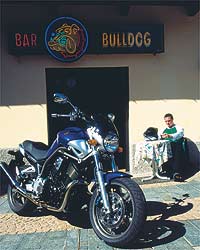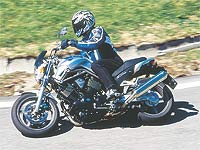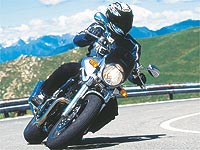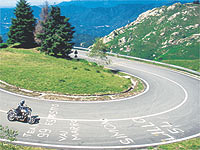First full test on the Bulldog
2 Jul 2001 By Adam Morrissey.
We carried first impressions direct from Italy on Friday. Now here’s the test in full On Friday we heard from Adam Morrissey with his first impressions on the new Yamaha Bulldog. Now after some reflection and consideration, here’s his verdict on the first bike Yamaha has both designed and built outsideJapan… It looks like it should be competing with a Buell or a Monster. But in reality the Bulldog, despite the aggressive looks and name, is more cruiser than back-lane hoodlum. |
 |
The sit-up riding position, wide bars and minimal protection from the elements all give the impression of a streetfighter with more attitude than Chris Evans. But the engine has been lifted from the 1100 Drag Star cruiser. It has been reworked, but not hugely, and retains the five-speed gearbox, the low red line and the low-down torque. It is, to all intents and purposes, a cruiser engine. And, at heart, the Bulldog is a cruiser for people who don’t like cruisers. Yamaha’s main aim was comfort and ease of use – hence the shaft-drive. This is for people who don’t want to get their hands dirty. It’s also for people who want a leisurely, relaxing ride rather than for those who want to be able to turn up the performance and get from A to B faster than anyone else on the road. |
 |
The early-morning sun is still melting the mist from Lake Como as we take charge of the bikes during the launch in Italy. Yamaha’s spokesman had described them as "solid metal motorbikes". He ain’t wrong. There’s more metal on display here than in a scrapyard. It’s not just the deeply-finned 1100cc motor, either. The stone deflectors on the fork sliders are hewn from the shiny stuff, and even the switchgear is mounted on metal rather than the usual plastic. The same goes for many other details, which probably accounts for much of the bike’s 229kg (503lb) dry weight. |
 |
One detail that is plastic is the choke lever. With the sun rising and the day rapidly developing into a hot Italian Friday, we were never going to need to use the choke, but when you look, you notice there isn’t one on the bars. That’s because, in classic retro style, it’s on the side of the engine. We’ll have to wait for a British winter to find out how it copes. That said, a British winter may not be something these bikes ever get used to. The quality feels good, but no metal likes being immersed in the gritty, salty sludge that covers our roads through the dark months. Few owners are likely to want to spend half the weekend cleaning the machine after a little ride – this is intended to be a bike for low-maintenance, hassle-free riding, remember. But owners will be proud of their bike’s looks, so instead of getting their hands dirty they’re likely to keep their Bulldogs dry and snug in the garage all winter. That choke lever may barely move. After taking a good look around the machine, we swing ourselves into the seat and get ready to head out into the holiday traffic around one of Italy’s most popular tourist areas. |
 |
Another part of the bike Yamaha is keen to promote is the sound. It's a pretty tough demand getting anything other than a strangled whine out of an engine these days, with noise limits what they are. OK an engine doesn't have to be loud to sound good, but there's something about that head-turning V-twin purr that's very satisfying.
At first, the pair of big chrome end cans, with tiny spouts at the end barely big enough to stick your index finger down, don't look promising. In fact, you do get a fair amount of classic V-twin boom. This isn't Italian soul, this isn't Japanese clinical clean. This is lumpy, irregular American rumble - which it should be with the custom bike engine, of course. Unfortunately, there isn't quite enough of it.
Something that's clear right from the start is this hasn't got a long-distance seat. It simply isn't comfy enough. It looks wide and deeply padded, but it's also very soft, which means you sink into it. After a while, it feels like you're sitting on the top tube of the frame. It's also canted forward at quite an angle so you end up involuntarily hugging the fuel tank. The pillion seat is more comfortable - much better suited to what should be an impressive range from the 20-litre (4.4 gallon) tank. There's no fuel tap, just a light warning you you're down to the final 5.8 litres (1.3 gallons). Frankly, you're unlikely to run out, just because you'll want a break before you've gone that far. Yamaha hasn't published fuel consumption figures yet, but an engine like this should easily be capable of 40mpg - that would see it do nearly 180 miles between stops. Not many of the target buyers are going to need that sort of range.
The soft seat, combined with the big tank, gives you a very "sit in" rather than "sit on" feel. The riding position is pretty upright, the pegs are nicely placed and the wide bars give you more leverage to help overcome the torque reaction common to shaft-drive bikes. (a shaft usually makes it harder to lean a bike to one side than the other, as you have to turn against the direction the shaft is spinning in).
The engine red-lines at a lowly 7000rpm and it gets there pretty quickly and easily. Peak torque is at just 4500rpm, but you'd hardly notice - the torque curve is so flat you really get a wide plateau of drive from 3000rpm to 6000rpm. With just five cogs to juggle, the gears are pretty widely spaced. Each time you change gear you drop a couple of thousand revs. That's fine as there's drive from everywhere, but it makes the bike feel relaxed.
Overtaking is an odd affair. You don't hang on to a gear and use the revs to blast by - you're more likely to go up a gear and just drive through the meat of the torque. You'll get past fine, but acceleration isn't stunning so you start to plan those overtakes with extra care. The narrow, winding roads around the lake don't give many long straights or the space to feel comfortable making an extra lane between opposing lines of traffic. So you look ahead, check how far the next corner is and mentally calculate if you'll get past before a car appears out of the bend towards you.
The neat little rev-counter nestling in the bottom of the speedo needs a lot of checking for these manoeuvres - and you can actually read what it says, because, despite 1063cc of V-twin under you, the bike is pretty vibe-free. Even when you rev it into the red you notice the power tail off before there's any intrusive vibration. That may be due to the rubber-mounted footpegs and soft seat, but it's also a testament to how well Yamaha has put the engine together.
Off the main traffic routes and up into the hills, the Bulldog begins to really show off its handling. A long series of hairpin turns over some of the worst road surfaces in Italy becomes a sort of hillclimb endurance event. We're rising rapidly enough to make our ears pop and the twin-cylinder grunt makes it an easy corner-to-corner sprint.
Again, you have to make the comparison with a cruiser rather than the sportier bikes the Bulldog resembles. Like a cruiser, it carries its weight very low. That low-slung weight makes cruisers easy to tip from upright to fully cranked over, but their length makes them more barge-like around the turns. The Bulldog makes far easier work of the twists than any custom machine and encourages us to give it a harder workout. And that proves its downfall - quite literally for some. The pegs have moulded hero-blobs rather than screw-in ones. That means they're alloy rather than steel. Not much of a lean angle is needed to make them touch down and within a short time they're worn flat to the peg. It doesn't take long for other bits to touch - and for two bikes to find themselves on the floor.
What we think happened is the soft suspension combined with the torque reaction as you shut the throttle made the bikes really settle mid-corner. That let the front cylinder's downpipe scrape and pick the tyres up. Both were low-speed spills and underline the difference between the looks and the target. The bike comes across like a sportster, but dynamically it's a cruiser, in terms of cornering as well as engine performance. Even at 110mph, the tiny screen makes the wind blast easily bearable - you could probably stand that on the autobahn longer than you could put up with the seat.
On a sports bike, you'd easily find the limits of the tyres - Dunlop D205 touring front and rear. On this, they seem just right. The bike is stable everywhere, even over the roughest parts of the road, and the grip is more than enough for the small lean angles available.
The brakes, too, do a good job. Knowing that the calipers could easily have ended up bolted to your mate's R1, you'd expect that. You have to approach it as a custom bike. If you really fancy the idea of cruising and posing without having to go fast, but you don't get on with the riding position or just don't like the look, this could hit the nail on the head for you.
But as well as the weekend rider, there's another potential market for this - the town rider. It comes close to a monster trailie when you get into the traffic, as we find trying to navigate back to the hotel at the end of a day's riding. The upright riding position gives good visibility, the lazy engine means fewer gearchanges as the traffic opens up, and there's enough steering lock to take advantage of every gap. With this amount of traffic around, the fact that the engine isn't too powerful doesn't really matter, either. You can just get on with slipping past, while those Alfa and Fiat drivers fume in the heat.
"What you see is what you get", Yamaha had told us before we rode the bikes. But that's not true. Because you're seeing a Ducati Monster or a Buell and the Bulldog just isn't doing the same thing as that at all. What it is doing is answering a question nobody has ever asked before. Yamaha believes there's a market out there for a bike that offers relaxed riding, a definite style that'll get you noticed and the security of a major Japanese brand and it has staked its claim. Other manufacturers will doubtless watch its success before they decide whether to follow the same route.
*****************************************